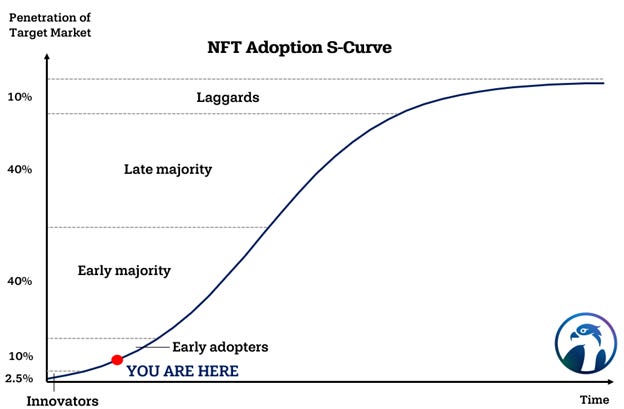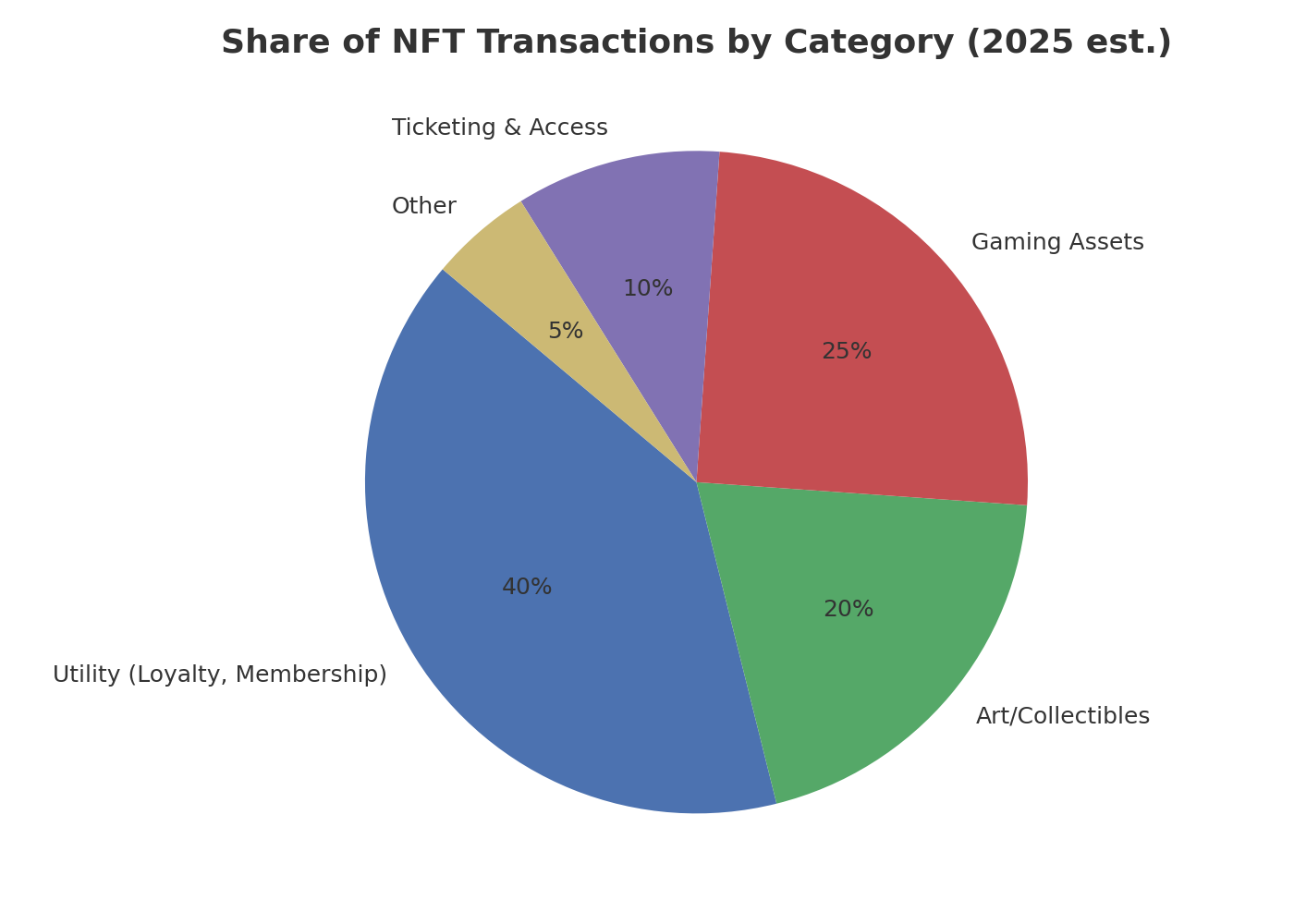NFTs After the Hype: Utility, IP, and Enterprise Use Cases That Work
The NFT bubble may have burst, but the technology is quietly building its next chapter, one rooted in utility, intellectual property, and enterprise adoption.
NFTs aren’t dead, they’re evolving. The speculative mania that drove JPEGs to multimillion-dollar valuations has faded, with overall NFT trading volume dropping more than 70% from its 2022 peak according to DappRadar. Yet behind the crash, something more durable is taking shape: enterprise adoption and utility-driven experiments that reframe NFTs as digital infrastructure rather than lottery tickets.
The real story? We’re past speculation. NFTs are moving into loyalty programs, ticketing, brand IP, and enterprise systems. This shift may not make headlines like $69 million art auctions, but it could be the foundation of the next wave of digital property rights.
Why NFTs Still Matter in 2025
In 2025, NFTs are less about flexing on Twitter and more about embedding value into everyday experiences. Consider Nike when it launched .SWOOSH, its Web3 platform for co-creating and owning digital sneakers, tying NFTs directly to community engagement and brand storytelling.
The takeaway: brands are shifting from hype to integration. For consumers, this means NFTs no longer exist as speculative “collectibles” alone. Instead, they show up in loyalty apps, product drops, and entertainment experiences, often invisible as blockchain, but impactful as digital ownership.
Utility NFTs: The Real Use Cases
The strongest momentum for NFTs today comes from utility-first use cases that solve problems beyond speculation. Three categories stand out:
Membership & Loyalty
Brands like Starbucks, Reddit, and Adidas are experimenting with NFTs as digital membership passes. Reddit’s Collectible Avatars quietly onboarded millions of users into NFTs without fanfare. Adidas has tied NFTs to exclusive product drops, turning digital assets into keys for community perks.
Ticketing & Access
NFTs are also reshaping event ticketing. Coachella sold lifetime NFT passes, while Ticketmaster piloted NFT tickets to reduce fraud and add resale royalties. Imagine a future where your festival wristband doubles as a digital collectible with utility — proof of attendance, access to future presales, or even resale market value.
In-Game Assets
Gaming is another natural frontier. Immutable and Epic Games are embedding NFT assets into games, creating secondary economies for skins, weapons, and virtual land. Unlike speculative art, these assets have clear purpose: they unlock gameplay value and resale opportunities.
Data backs this up: by 2025, over 60% of NFT activity is tied to non-art utility-based use cases, according to Chainalysis.
IP & Ownership: Beyond JPEGs
Another underappreciated dimension of NFTs is their function as IP wrappers. When a creator issues an NFT, it can represent licensing rights, royalty streams, or co-ownership in intellectual property.
Take Yuga Labs and the Bored Ape Yacht Club. Holders were granted rights to commercialize their Apes, spawning coffee brands, music groups, and even Hollywood deals. This experiment turned NFTs from collectibles into vehicles for licensing revenue.
But here’s the catch: enforcement is messy. While a token may claim ownership, enforcing IP rights across jurisdictions is fraught with risk. What happens when two parties in different countries dispute rights tied to the same NFT? The law hasn’t caught up.
Enterprise Adoption: Where the Money Is
The biggest opportunities may lie in enterprise adoption. Luxury brands like LVMH are using NFTs and blockchain to ensure product authenticity. I wrote an article in 2022, highlight 15 brands adopting NFTs. While the adoption has slowed down since then (quite dramatically acutally), in a world where counterfeit goods represent nearly $500 billion in global trade, this shift is more than a tech experiment, it’s a defence against one of the industry’s largest threats.
Here’s where it gets tangible. Imagine buying a Louis Vuitton bag, scanning a discreet QR code stitched inside, and instantly pulling up its blockchain certificate of authenticity. No middleman, no guesswork, just proof that what you own is the real deal. That kind of trust is invaluable, not just for luxury buyers but for anyone who’s ever second-guessed a purchase.
The same logic extends to sneakers. Nike’s .Swoosh NFTs don’t just unlock digital wearables; they connect your digital identity to exclusive real-world drops. For sneakerheads, it’s less about flipping JPEGs and more about belonging to a brand-powered ecosystem where ownership brings access.
And it doesn’t stop at fashion. Warner Music’s partnership with Polygon experiments with fan engagement, while IBM explores NFTs as wrappers for patents and IP rights. Taken together, these moves signal a broader trend: NFTs are becoming invisible infrastructure for enterprise — baked into how brands build trust, reward loyalty, and manage digital assets.
Which begs the bigger question: if luxury and lifestyle brands are embedding NFTs into their customer experience today, how long before this becomes the default for all premium goods and services?
Risks & Outlook (2026)
Of course, risks remain. Liquidity in NFT markets has collapsed, leaving many tokens unsellable. IP disputes are unresolved, with legal gray zones around royalties and licensing. Regulation continues to lag behind innovation.
Yet the outlook isn’t bleak. Enterprise-driven NFTs are projected to grow steadily at 25% annually through 2026 (Messari). Emerging innovations, like AI-powered dynamic NFTs that evolve over time, add fresh use cases. And even if the term “NFT” fades, the underlying tech could quietly power the next era of digital property rights.
Staying Ahead of the Curve
To navigate the shifting NFT landscape, focus less on daily floor prices and more on long-term signals:
Follow utility-first projects like Nike, it shows how NFTs can integrate seamlessly into customer experiences.
Track IP experiments from Yuga Labs and Azuki, they’re testing how communities can become co-creators, not just collectors.
Watch enterprise adoption in supply chains, luxury, and entertainment. LVMH uses NFTs for product authentication, while gaming and ticketing pilots are pushing real-world applications further.
The signal is clear: NFTs aren’t a passing fad, they’re becoming infrastructure. The next wave won’t be measured in speculative volume but in how deeply NFTs embed into business models and daily experiences.
What about you? Which NFT use case feels most impactful? Ticketing, loyalty, or digital identity?
From Hype to Infrastructure
NFTs aren’t dead,they’re maturing. The hype cycles of apes and pixel art gave us the cultural spark, but the real story is happening now: loyalty platforms, authenticated supply chains, ticketing, and digital IP experiments are proving NFTs can move beyond speculation.
For builders, investors, and curious readers alike, the question isn’t if NFTs survive, it’s how they’ll quietly weave into the systems we already use every day. From buying sneakers to proving authenticity in luxury goods, NFTs are shifting from collectibles to infrastructure.
This is the evolution worth tracking.
If you want more deep dives like this, subscribe to canhav.com, where we cut through hype and surface the real signals in crypto’s next phase.





